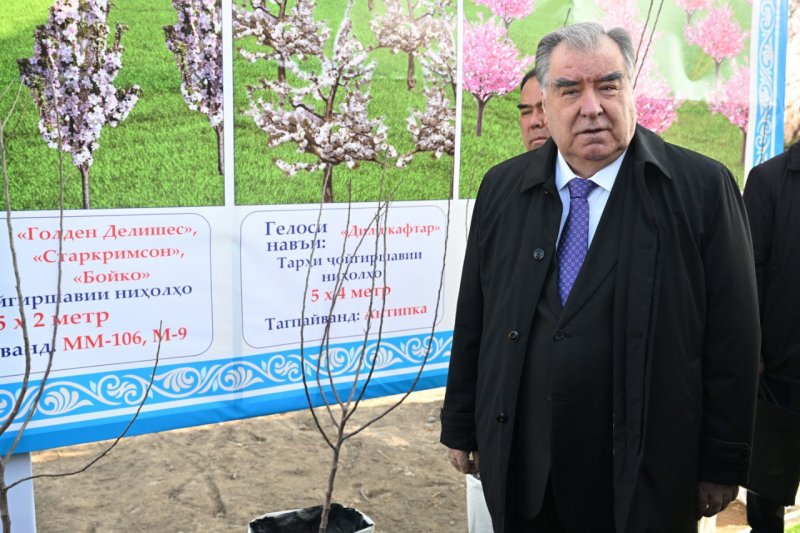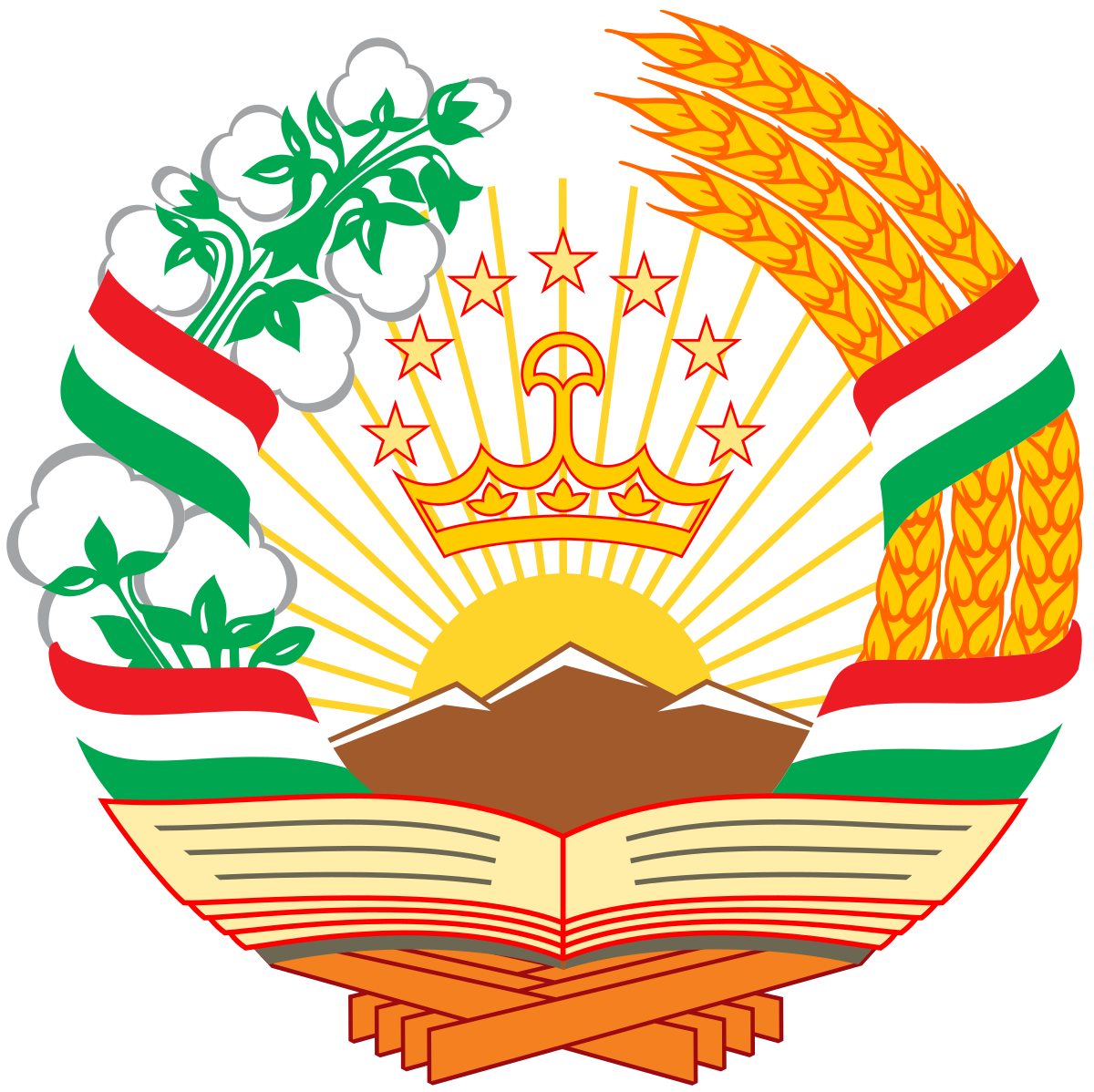Leader of the Nation familiarizes with process of creating an intensive garden in Bobojon Ghafurov district
Read also

On March 29, the working visit of the President of the Republic of Tajikistan, Leader of the Nation, Honorable Emomali Rahmon, to Sughd Province began from the village of Ovchikalacha in the Bobojon Ghafurov district.
In the village of Ovchikalacha, the Head of State planted fruit trees in the intensive garden of the branch of the Institute of Horticulture, Viticulture and Vegetable Growing of the Academy of Agricultural Sciences of Tajikistan in the Sughd Province for the sake of greenery and abundant harvests, and guided the people of the district, scientists and agricultural workers to expand greening and fruiting practices.
The intensive garden covers a total area of 20 hectares and was created mainly on the site of an old apricot orchard that had ceased to bear fruit after more than 30 years. Of this figure, 10 hectares are apple and cherry orchards, and another 10 hectares are peach orchards. In the newly built garden, drip irrigation has been installed to ensure the germination of seedlings.
During the conversation with scientists, farmers and other agricultural workers, it was emphasized that when creating gardens, more attention should be paid to the correct selection of a site for growing seedlings and increasing the area of gardens with a yield aimed at export.
According to the information, the branch has 564 hectares of agricultural land, of which about 400 hectares are gardens and more than 80 hectares of vineyards are the result of many years of work by scientists of this scientific institution.
Scientists and employees of the branch of the Institute of Horticulture, Viticulture and Vegetable Growing of the Academy of Agricultural Sciences of Tajikistan in Sughd Province also erected an intensive garden on an area of 4 hectares in 2014. The rest are traditional gardens and vineyards, and the results are significant in terms of implementing scientific achievements and advanced practices in production.
According to scientists, intensive gardens are more economically beneficial than traditional gardens, have been experimented with in the country for many years, and they begin to bear fruit in three to four years.
The land between the rows of gardens is also used efficiently and rationally. That is, until the seedlings grow, various agricultural crops are planted and grown between the rows.
In the first year, scientists from the branch of the Institute of Horticulture, Viticulture and Vegetable Growing of the Academy of Agricultural Sciences of Tajikistan in Sughd Province planted onions, carrots and watermelons on an area of 6 hectares, 4 hectares, and 2 hectares of film-covered watermelons between the rows of the new intensive garden. At the same time, anzur onions are grown on a small area for experimentation. These two types of crops have also been planted in separate plots to obtain seeds of carrots and high-yielding tomatoes. The characteristics of the crop are fully studied from the planting period to harvesting.
Scientists of the branch are strengthening scientific and research activities in priority areas of agriculture, including horticulture and viticulture, vegetable growing and potato growing.
It was reported that to date, the branch of the Institute of Horticulture, Viticulture and Vegetable Growing of the Academy of Agricultural Sciences of Tajikistan in Sughd Province has obtained 12 copyright certificates for the creation of 8 varieties of apricots, one variety of carrot and one variety of grape. At the same time, two varieties of apricots, 3 varieties of grapes, two varieties of anzur onions and one variety of onion, created by the scientists of the branch, are being tested.
While getting acquainted with the agrarian potential of this region, the Head of State Emomali Rahmon considered the initiative of the officials of the Academy of Agricultural Sciences of Tajikistan to restore old orchards as important and timely.
It is worth noting that every year in Sughd Province, as part of the implementation of state programs, new orchards and vineyards are created and the volume of fruit production is increased by timely implementation of agrotechnical measures.
The total area of gardens in all economic sectors of the region is more than 70 thousand hectares, and of this figure, about 60 thousand hectares are productive.
Farmers in the region are very interested in the creation of intensive and super-intensive gardens. That is, of the total area of the created gardens, intensive and super-intensive gardens account for almost 1000 hectares.











 President Emomali Rahmon attends International Forum on Peace and Trust in Ashgabat
President Emomali Rahmon attends International Forum on Peace and Trust in Ashgabat President of Tajikistan Emomali Rahmon reaffirms commitment to developing cooperation with Turkmenistan within strategic partnership
President of Tajikistan Emomali Rahmon reaffirms commitment to developing cooperation with Turkmenistan within strategic partnership President Emomali Rahmon arrives in Turkmenistan on a working visit
President Emomali Rahmon arrives in Turkmenistan on a working visit President Emomali Rahmon departs for Turkmenistan to attend Int’l Peace and Trust Forum
President Emomali Rahmon departs for Turkmenistan to attend Int’l Peace and Trust Forum President Emomali Rahmon attended ceremony to commission the building of Regional Department of the State Financial Control and Anti-Corruption Agency
President Emomali Rahmon attended ceremony to commission the building of Regional Department of the State Financial Control and Anti-Corruption Agency President Emomali Rahmon participated in opening of Tursunzoda Market in Tursunzoda
President Emomali Rahmon participated in opening of Tursunzoda Market in Tursunzoda President Emomali Rahmon attends inauguration of the aluminum products plant in Tursunzoda
President Emomali Rahmon attends inauguration of the aluminum products plant in Tursunzoda President Emomali Rahmon attended the inauguration of six private kindergartens in Tursunzoda
President Emomali Rahmon attended the inauguration of six private kindergartens in Tursunzoda President Emomali Rahmon attended the opening of Ghunchahoi Istiqlol Kindgergarten in Tursunzoda
President Emomali Rahmon attended the opening of Ghunchahoi Istiqlol Kindgergarten in Tursunzoda President Emomali Rahmon participated in opening of eight secondary educational institutions in Tursunzoda
President Emomali Rahmon participated in opening of eight secondary educational institutions in Tursunzoda President Emomali Rahmon attended the opening of secondary school in Tursunzoda
President Emomali Rahmon attended the opening of secondary school in Tursunzoda President Emomali Rahmon attended the opening ceremony of second phase of aluminum products plant in Tursunzoda
President Emomali Rahmon attended the opening ceremony of second phase of aluminum products plant in Tursunzoda














